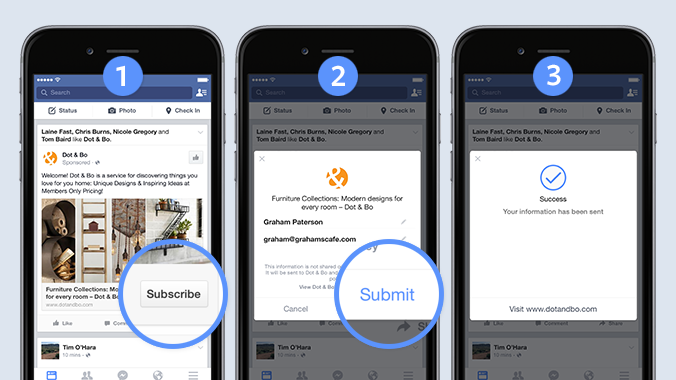The 10 Best Facebook Ad Targeting Tips for Your Business

Did you know that Facebook now has more users (1.7 billion) than the entire population in China?
That was just one of the many interesting pieces of information Sarah Rogers, Manager, Performance Social at CPC Strategy mentioned in our Facebook webinar earlier this month.
If you didn’t get a chance to attend the event, we’re providing a recap on how Facebook ad targeting capabilities have grown tremendously throughout 2016 and what your business can expect in the new year.
“There’s been several new social channels that have recently opened up their capabilities in the past couple years: For example, Snapchat being one that comes to mind for most people,” Rogers said.
“However, according to RBC Capital Markets when you look at all of the social channels, Facebook still dominates in every single age cohort as seen in the data (below)”

The only segment Facebook is not dominating in is the 13 to 18 year old market.
“That for us as retailers, if perfectly fine (for now) since they are not really part of the sales funnel quite as much. However, this is definitely something to watch in the future & see how Facebook is able to convert these younger users & continue their exponential growth.”
“Right now Google is taking up 15 – 17% of the advertising share (including TV, radio). Facebook can be just as big, even though right now it’s only at 5%, we are expecting a growth to 7% in 2017.”
“The 2016 Guide to Facebook Retargeting“
The variety of audience types that Facebook is coming out with continues to expand. Below we’ve listed the top targeting options preferred by advertisers. Keep in mind some of these features are actively rolling out, so they might not be available via your Power Editor just yet.
Pro-Tip: In order to target people on your website, you need to have the latest Facebook Pixel installed correctly on your site. The Pixel is now a requirement for all Facebook advertisers and is helpful to target specific product pages, cart abandoners, etc.
1) All Website Visitors – As seen in the example below you can target all website visitors, segmenting by: 1 day (which is useful for those not actively running Facebook Dynamic Ads), 90 days or up to 180 days (which serves as “catch-all” to make sure you’re not missing anyone).

2) Specific Web Pages (Targeting & Excluding) – For example, you can target someone who added to cart but did not purchase, or someone who has visited the site and clicked around but hasn’t converted.
For some of our clients we also use this as an exclusion for past purchasers. If someone purchased an item recently they are most likely not going to purchase again anytime soon, so we exclude them.
3) Email List Segments or Tags (Targeting or Excluding) – You can also upload your email list(s) into Facebook. This comes with a variety of identifier options (as seen below).
For example, maybe you have customers who purchase your products on Amazon but you don’t have access to their email, instead – you have their phone number or location. No problem! Facebook allows you to enter a variety of alternative information outside of just email addresses (including zip code, gender, age, and more) to better grow and target your segment.

“We use CRM lists as one of our key metrics for targeting first party customers,” Ryan Bates, Digital Production Coordinator at CPC Strategy said.
 “The people signing up for your email list are obviously going to be the most devoted since they’ve already showed an interest in your brand. From an advertising standpoint they are a key market to go after. You can also build lookalikes off of them.”
“The people signing up for your email list are obviously going to be the most devoted since they’ve already showed an interest in your brand. From an advertising standpoint they are a key market to go after. You can also build lookalikes off of them.”
“We recommend if you do set up a CRM list that you update it on a regular basis. We tend to get updated lists every month from our clients, and Facebook makes it really easy to add in additional users to those lists so you don’t have to create a brand new list every month.”
4) Time on Site – This is another audience based off of your Facebook pixel. “Time on Site” is targeting people who have spent a significant amount of time on your site. This is a brand new segment and according to Bates, we’ve seen success using this targeting strategy with both our Facebook retail clients and even for our own ecommerce blog.
5) Engagement on Facebook – You are now able to target based off of people who have engaged with your organic Facebook page, as well as the posts, a lead ad or even video. Targeting based on video engagement has been around for a quite some time but the latest introduction of targeting based on lead ad (as seen below) or a canvas ad is new.

The exciting part about Facebook engagement targeting is that advertisers are finally able to connect activity on the organic side with their paid advertising efforts.
6) Lookalike Audiences – This feature allow advertisers to target consumers who mirror or look similar to former or already existing customers they may have.
This audience option is incredibly valuable, as it allows advertisers to reach an entirely new group of prospective customers, identical to previously converted customers, they may not have found otherwise. This can be applied to people who visited your site, CRM list, or those who have engaged with your Facebook page.
7) Fans – You are also able to target fans of your Facebook page. Right now the Facebook Algorithm only shows about 10% of your page likes, which is why you tend to see that the reach is a lot smaller on an individual post than the actual page likes on your page. Fan targeting is a great way to relay an important message to people interested in your brand and / or products.
Pro-tip: You can also target “Friends of Fans”. This includes anyone that is a fan of your page and their friend groups. We typically use this as a layering tactic on top of other audiences.
8) Behaviors – Behaviors are constructed based on someone’s activity on Facebook, as well as offline activity provided provided by trusted third-party Facebook partners. Similar to interests, this Facebook targeting option has an astounding number of categories and subcategories. You have the ability to reach people based on purchase behaviors or intents, device usage and more.
9) Interests – Interests includes the types of posts users share on their timelines, apps they use, and pages they like. The interests section has a nearly limitless number of options to choose from. You can search relevant topics or choose from a list of categories, each containing an abundance of subcategories.

10) Demographics – The demographics option allows you to reach people based on, well, just about anything. The number of choices you have to choose from can be a bit overwhelming. And for advertisers, that’s a good problem to have.
You can target based on:
To learn more about additional Facebook Targeting Options, also check out our recent blog post.
